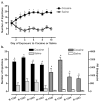A within-subject assessment of the discriminative stimulus and reinforcing effects of self-administered cocaine in rhesus monkeys
- PMID: 18807249
- PMCID: PMC2738977
- DOI: 10.1007/s00213-008-1322-5
A within-subject assessment of the discriminative stimulus and reinforcing effects of self-administered cocaine in rhesus monkeys
Abstract
Rationale: Drug discrimination (DD) and drug self-administration (SA) are frequently used preclinical assays. All preclinical studies with cocaine have examined the discriminative stimulus (S(D)) and reinforcing (S(R)) effects in separate groups of subjects.
Objective: The objective of the study is to train drug-naïve rhesus macaques to discriminate self-administered cocaine from saline and to assess S(D) and S(R) effects using a within-subjects design.
Materials and methods: Adult male rhesus monkeys (n = 4) were trained to self-administer cocaine (0.1 mg/kg per injection) under a progressive-ratio (PR) reinforcement schedule. Next, they were trained to discriminate self-administered cocaine (0.45 or 0.56 mg/kg) or saline under a fixed-ratio (FR) 50 schedule of food presentation. The final schedule combined DD and SA into a multiple [chained FR 50 SA (cocaine or saline), food-reinforced DD] and PR SA schedule.
Results: Each subject acquired SA under a PR schedule with significant differences in breakpoint between saline and cocaine evident by session 5. Self-administered cocaine was established as an S(D), such that 80% of responding before delivery of the first reinforcer and 90% of all responding occurred on the injection-appropriate lever. In all monkeys, there was at least one cocaine dose that did not engender cocaine-appropriate responding during DD (i.e., <20% cocaine-appropriate responding) yet functioned as a reinforcer during PR SA, suggesting that cocaine-like S(D) effects are not necessary for cocaine reinforcement.
Conclusions: This within-subject model may provide new information related to the behavioral mechanisms of action leading to the high abuse potential of cocaine; such information may lead to novel pharmacological treatment strategies for addiction.
Figures





Similar articles
-
Effects of varenicline on the reinforcing and discriminative stimulus effects of cocaine in rhesus monkeys.J Pharmacol Exp Ther. 2011 Nov;339(2):678-86. doi: 10.1124/jpet.111.185538. Epub 2011 Aug 19. J Pharmacol Exp Ther. 2011. PMID: 21856860 Free PMC article.
-
Dopamine D2/D3 receptors modulate cocaine's reinforcing and discriminative stimulus effects in rhesus monkeys.Drug Alcohol Depend. 1999 Apr 1;54(2):97-110. doi: 10.1016/s0376-8716(98)00162-8. Drug Alcohol Depend. 1999. PMID: 10217549
-
The influence of reinforcing effects of cocaine on cocaine-induced increases in extinguished responding in cynomolgus monkeys.Psychopharmacology (Berl). 2007 Jul;192(4):449-56. doi: 10.1007/s00213-007-0732-0. Epub 2007 Feb 21. Psychopharmacology (Berl). 2007. PMID: 17318506 Free PMC article.
-
Contributions to drug abuse research of Steven R. Goldberg's behavioral analysis of stimulus-stimulus contingencies.Psychopharmacology (Berl). 2016 May;233(10):1921-32. doi: 10.1007/s00213-015-4149-x. Epub 2015 Nov 13. Psychopharmacology (Berl). 2016. PMID: 26564234 Free PMC article. Review.
-
Computational psychopharmacology: a translational and pragmatic approach.Psychopharmacology (Berl). 2019 Aug;236(8):2295-2305. doi: 10.1007/s00213-019-05302-3. Epub 2019 Jul 4. Psychopharmacology (Berl). 2019. PMID: 31273400 Free PMC article. Review.
Cited by
-
Discriminative stimulus effects of NMDA, AMPA, and mGluR5 glutamate receptor ligands in methamphetamine-trained rats.Behav Pharmacol. 2011 Sep;22(5-6):516-24. doi: 10.1097/FBP.0b013e328349aafa. Behav Pharmacol. 2011. PMID: 21836462 Free PMC article.
-
Medication discovery for addiction: translating the dopamine D3 receptor hypothesis.Biochem Pharmacol. 2012 Oct 1;84(7):882-90. doi: 10.1016/j.bcp.2012.06.023. Epub 2012 Jul 3. Biochem Pharmacol. 2012. PMID: 22781742 Free PMC article. Review.
-
2016 Philip S. Portoghese Medicinal Chemistry Lectureship: Designing Bivalent or Bitopic Molecules for G-Protein Coupled Receptors. The Whole Is Greater Than the Sum of Its Parts.J Med Chem. 2020 Mar 12;63(5):1779-1797. doi: 10.1021/acs.jmedchem.9b01105. Epub 2019 Sep 24. J Med Chem. 2020. PMID: 31499001 Free PMC article.
-
Assessing the Value of the Zebrafish Conditioned Place Preference Model for Predicting Human Abuse Potential.J Pharmacol Exp Ther. 2017 Oct;363(1):66-79. doi: 10.1124/jpet.117.242628. Epub 2017 Aug 8. J Pharmacol Exp Ther. 2017. PMID: 28790193 Free PMC article.
-
Do initial responses to drugs predict future use or abuse?Neurosci Biobehav Rev. 2012 Jul;36(6):1565-76. doi: 10.1016/j.neubiorev.2012.04.005. Epub 2012 Apr 21. Neurosci Biobehav Rev. 2012. PMID: 22542906 Free PMC article. Review.
References
-
- Ator NA. Relation between discriminative and reinforcing effects of midazolam, pentobarbital, chlordiazepoxide, zolpidem, and imidazenil in baboons. Psychopharmacology. 2002;163:477–487. - PubMed
-
- Bigelow GE, Preston KL. Drug discrimination: methods for drug characterization and classification. NIDA Res Monogr. 1989;92:101–122. - PubMed
-
- Brady JV, Lukas SE. Testing drugs for physical dependence potential and abuse liability. NIDA Res Monogr. 1984:52. - PubMed
-
- Carroll ME. PCP and hallucinogens. Adv Alcohol Subst Abuse. 1990;9:167–190. - PubMed
-
- Colpaert FC. Drug discrimination in neurobiology. Pharmacol Biochem Behav. 1999;64:337–345. - PubMed
Publication types
MeSH terms
Substances
Grants and funding
LinkOut - more resources
Full Text Sources
Research Materials

